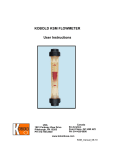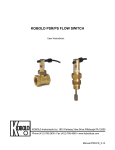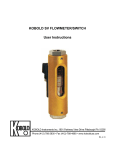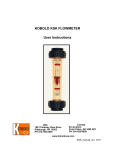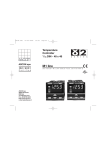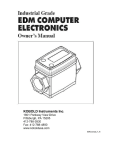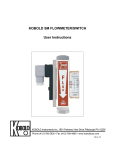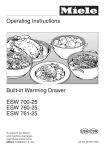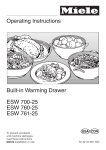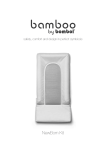Download NBK - Bypass Level Indicator Manual
Transcript
KOBOLD NBK Bypass Level Indicator User Instructions KOBOLD Instruments Inc. 1801 Parkway View Drive Pittsburgh PA 15205 Phone (412) 788-2830 • Fax (412)-788-4890 • www.koboldusa.com Manual-NBK_10-4-02 NBK Table Of Contents KOBOLD NBK BYPASS LEVEL INDICATOR 1.0 General . . . . . . . . . . . . . . . . . . . . . . . . . . . . . . . . . . . . . . . . . . . . . . . . . . . . 1 2.0 Specifications . . . . . . . . . . . . . . . . . . . . . . . . . . . . . . . . . . . . . . . . . . . . . . . . 2 3.0 Installation Instructions. . . . . . . . . . . . . . . . . . . . . . . . . . . . . . . . . . . . . . . . . 3 3.1 Mechanical Installation. . . . . . . . . . . . . . . . . . . . . . . . . . . . . . . . . . . . 3 3.2 Switch Electrical Installation. . . . . . . . . . . . . . . . . . . . . . . . . . . . . . . . 4 3.3 Transducer Electrical Installation. . . . . . . . . . . . . . . . . . . . . . . . . . . . 5 4.0 Operation . . . . . . . . . . . . . . . . . . . . . . . . . . . . . . . . . . . . . . . . . . . . . . . . . . . 7 5.0 Arrival of Damaged Equipment . . . . . . . . . . . . . . . . . . . . . . . . . . . . . . . . . . 7 6.0 Maintenance. . . . . . . . . . . . . . . . . . . . . . . . . . . . . . . . . . . . . . . . . . . . . . . . . 7 7.0 Need Help With Your NBK?. . . . . . . . . . . . . . . . . . . . . . . . . . . . . . . . . . . . . . 8 List of Diagrams Diagram 3.1 Switch Wiring . . . . . . . . . . . . . . . . . . . . . . . . . . . . . . . . . . . . . 4 Diagram 3.2 Wiring for Resistance Analog Transducer with Remote transmitter . . . . . . . . . . . . . . . . . . . . . . . . . . . . . . . . . . . . . . . 5 Diagram 3.3 Wiring for Analog Transducer with Integral Transmitter. . . . . . 6 List of Tables Table 2.1: General Specifications & Operational Limits . . . . . . . . . . . . . . . . . . . 2 Table 2.2: Electrical Data. . . . . . . . . . . . . . . . . . . . . . . . . . . . . . . . . . . . . . . . . . 2 FM Rev. 10/4/02 NBK KOBOLD NBK BYPASS LEVEL INDICATOR User Instructions CAUTION: 1.0 For safety reasons, please read the cautionary information located at the end of the manual, before attempting installation. General The KOBOLD NBK Bypass Level Indicator is used for the continuous measurement, indication, and control of liquid levels in tanks. The NBK may be specified in many combinations with a wide variety of options. Unlike many competing products, the KOBOLD NBK incorporates a circular magnet in the float, allowing for positioning of point level switches, or other accessories, almost anywhere on the exterior surface of the bypass tube. Switch position flexibility allows level switch points to be as close as 1" apart. This combination of capabilities makes the KOBOLD NBK the most versatile level indicator currently available. Operation is very straightforward. The bypass tube is attached to a tank in which the user wishes to monitor level. The level in the bypass tube rises and falls in unison with the main tank level. A sealed float, containing a ring magnet, is inserted into the bypass tube. The float will then rise and fall with the main tank level. The circular magnet inside the float can then be used to achieve a number of functions: 1) Tank level can be visually determined through use of externally mounted magnetic indicators. Depending on the direction of float travel, the indicators are rotated with the magnetic field surrounding the float to expose either red or white surfaces. 2) Tank level may be determined electronically via several methods: A magnetically-coupled resistance transducer with a variable bridge resistance, proportional to float height. A magnetically-coupled restistance transducer and a KOBOLD remote transmitter (Model: DFM, DST or DFA), converting the variable bridge resistance into a current or voltage based signal. A magnetically-coupled resistance transducer and integrally mounted transmitter that converts the variable bridge resistance to a 4-20 mA, looppowered (2-wire) signal output. A magnetically-coupled magnetostrictive transducer and integrally mounted transmitter that provides a 4-20 mA, 4-wire signal output. 3) Point level switching is possible with use of externally-mounted reed switches . These switches are bistable in nature and are switched by the passage of the float past their mounted position. FM Rev. 10/4/02 NBK 2.0 2 Specifications Table 2.1: General Specifications & Operational Limits Bypass tube: Material: Maximum operating pressures: Maximum operating temperature With polypropylene rollers: With ceramic rollers: With switches: With transducer: Transducer with heat shield: Maximum Viscosity: Minimum liquid S.G.: Minmum measuring length: Maximum measuring length: Overall length: Ø 60.3 mm 1.4571 (316-Ti SS) 230, 580, 930, 1450 PSIG 212°F 750°F see Table 2.2 390°F 750°F 200 cPs 0.55 12" 19.7' single section, longer in two-piece dependent on measuring length Table 2.2: Electrical Data Limit contact:Option "R" Contact operation: Switching hysteresis: Switch capacity: Medium temperature: Ambient temperature: Protection: Connection: Housing: bistable SPDT contact approximately 15 mm 0.5A, 60VA, 220 VAC max. 250°F max. 160°F max. IP 65 (NEMA 4X) 10' PVC cable Polyamide Limit contacts: Options "RH","RHH" Contact operation: Switching hysteresis: Switch capacity: Medium temperature: Ambient temperature: Protection: Housing: FM Rev. 10/4/02 bistable SPDT contact approximately 15 mm 0.5A, 60VA, 220 VAC max. 424°F max. (RH) / 750°F max. (RHH) 160°F max. IP 65 (NEMA 4X) Die-Cast Aluminium, clamp connection 3 3.0 NBK Installation Instructions CAUTION: 3.1 For safety reasons, please read the cautionary information located at the end of the manual, before attempting installation. Mechanical Installation Magnetically operated level indicators are precision measuring instruments and should be treated with appropriate care. Check that all components have been provided and that the connection flanges of the tank and indicator match. Once this has been done, the level indicator may be mounted. We recommend that (when possible) the bypass tube connections on your tank be fitted with valves to allow servicing and removal of the NBK bypass tube without draining the main vessel. 3.1.1 Ensure that the float and bypass tube are free from ferrous particles which will stick to the float and may prevent it from moving freely in the bypass tube. 3.1.2 Align the fittings on the NBK with those on your tank. 3.1.3 If using threaded connections, wrap the NBK threads with PTFE tape to make installation and future removal easier. 3.1.4 If using flanged connections, first insure that all flanges have been installed, oriented and spaced according to specification. Align the NBK flanges with those on your vessel, insert gaskets between flanges, and incrementally tighten to the torque appropriate to the flange classification using a torque wrench. 3.1.5 The float is packed in the same shipping crate as the main bypass tube. Remove the lower flange of the bypass tube, and insert the float into the bypass tube so that the engraving (i.e. Media S.G., Serial Number, “TOP”) is uppermost. Radial float orientation is not important. 3.1.6 Once the float is in the tube, re-install the lower flange to the bypass tube using the supplied gasket and tighten with a torque wrench. FM Rev. 10/4/02 NBK 4 3.2 Switch Electrical Installation (option) Magnetically coupled limit switches may be mounted on the NBK for level control and alarm functions. The annular design of the NBK float magnet allows, within the guidelines outlined below, the switches to be positioned anywhere along the length of the bypass tube, although no higher or lower than the inlet and outlet ports. 3.2.1 If your NBK is equipped with the optional visual indicator roller assembly, mark the location of the assembly with respect to the bypass pipe using a pencil or permanent marker. Additionally, mark the top of the indicator roller assembly for reference. Support the indicator assembly as appropriate, loosen the band clamps and remove. Place in a safe location for later installation. 3.2.2 If your NBK is equipped with the optional magnetic reed contacts (packed separately), mount the switch to the bypass tube using the supplied clamps, with the wiring termination (wire or cable gland) facing downward. Allow sufficient clearance for reinstallation of the indicator roller assembly (if equipped). Ensure that the supply voltage and current is in accordance with the switch specifications, and are not exceeded even MOMENTARILY. If in doubt about possible loads, we suggest the use of contact protection relays to protect your reed switches. Electrical connections are made according to the wiring diagram as follows: Diagram 3.1: Switch Wiring All switches have three connection points: Blue (1), Black (2), and Brown (3). The Black wire (2) is the common for both switching functions (N/O or N/C). Blue (1) N/O Dry (float below the switch), closes on rising level Brown (3) N/C Dry (float below the switch), opens on rising level The float must initially pass by the switch once in each direction so that the switching function will be as shown in the wiring diagram and table. After the switch has been initialized, it is ready for operation and requires no maintenance. FM Rev. 10/4/02 5 NBK 3.2.3 Adjust the switch by sliding the switch along the length of the bypass tube and secure the clamp when at the desired level. Note: Hysteresis is the difference between contact closing and opening points. A hysteresis of approximately 15 mm of float travel is typical for all switches. You may need to readjust your setpoint to accommodate this difference. 3.2.4 If equipped, reinstall the indicator roller assembly (referencing the marks made upon removal) and secure the clamp assemblies. 3.3 Transducer Electrical Installation (option) The transducer is shipped from the factory, mounted and aligned on the exterior of the NBK bypass tube. The transducer mounting lugs are permanently welded to the bypass tube and are unable to be relocated. If it becomes necessary to remove the transducer for any reason, be sure to accurately mark the location of the assembly with respect to the bypass tube using a pencil or permanent marker. 3.3.1 If a variable resistance level transducer has been provided with a remotely mounted kobold controller/transmitter (model: DFA, DFM, DST), connections are made according to the following wiring diagram: Diagram 3.2 Wiring for Resistance Analog Transducer with Remote Transmitter wiring to DFA, DFM, DST Transducer Alone Full scale output resistance 5000 ohm (approx) Wire Color: Sensor (Internal) Terminal 1: White Yellow Terminal 2: Brown Red Terminal 3: Green Black Please Note: Wiring to terminals 1 & 2 may occasionally differ from what is shown in the diagram, depending on the desired output behavior (typically: min. level = 4mA, max. level = 20 mA) If an inverted response is desired (i.e. min. level = 20mA, max. level = 4 FM Rev. 10/4/02 NBK 6 mA), simply swap wiring between terminals 1 & 2. 3.3.2 If a continuous level transducer with an integrally mounted transmitter has been provided, it must be connected according to the following wiring diagram: Diagram 3.3 Wiring for Analog Transducer with Integral Transmitter Type 1: Resistor Chain with 2-wire transmitter (option: “RTW”) Type 2: Magnetostrictive sensor with 4-20 mA, 4-wire transmitter 4-20 mA Output 24 VDC In ± 20% + Out - Out +V GND To minimize interference caused by electrical fields from other circuits, the low-voltage and signal cables should not be installed in the same conduit with high voltage cables. Unscrew the cover and run supply lines through cable gland. Connect the remote sensor to the electronics according to the terminal connection diagram. FM Rev. 10/4/02 7 NBK NOTE: The controller/transmitter is delivered fully calibrated and ready for use. The calibration screws found inside the electronics housing need not be adjusted by the user. Customer adjustment of these screws often necessitates a recalibration of the unit. The precision of the instrument is guaranteed only if the calibration screws have not been adjusted. Contact Kobold Instruments for information if adjustment is deemed necessary. 4.0 Operation 4.0.1 Slowly open the drain plug or valve at the bottom of the unit to release any remaining liquid or gas and then close. NOTE: It is imperative that vents or drains fitted to the indicator are tightly closed prior to and during operation. 4.0.2 Slowly open upper isolation valve (if installed). 4.0.3 Slowly open lower isolation valve (if installed). 4.0.4 Verify that the installation is free of any leaks and repair if necessary. The liquid will now flow into the bypass tube, lifting the float with it. The bypass tube will continue to fill until the same level as in the main vessel is reached. As the float rises, all externally mounted options (limit switches, level indicator, analog transducer) will be activated as the float passes by their location. Switches will change state, visual level indicators will turn from white to red, and analog output transducers will increase their output signal. Your NBK is now in full operation. 5.0 Arrival of Damaged Equipment Your instrument was inspected prior to shipment and found to be defect-free. If damage is visible on the unit, we advise that you carefully inspect the packing in which it was delivered. If damage is visible, notify your local carrier at once, since the carrier is liable for a replacement under these circumstances. If your claim is refused, please contact Kobold Instruments for further advisement. 6.0 Maintenance The KOBOLD NBK normally requires very little maintenance, provided the measured medium is kept free of contaminants. Ferritic pollutants may affect this device due to the incorporation of magnets into the float assembly. From time to time, the drain plug or valve should be opened to drain out any dirt particles present in the measured liquid. Where dirt is not present, this procedure is not normally required. FM Rev. 10/4/02 NBK 8 Some installations may require regularly scheduled maintenance due to use with coating type media. When the NBK is used to monitor the level of this type of liquid, we recommend that periodically, the bottom flange, (or top and bottom flanges, if equipped) should be removed and the float carefully extracted. The bypass tube may then be mechanically cleaned, the unit re-assembled and placed back in service. 7.0 Need help with your NBK Level Indicator? Call one of our friendly engineers at 412-788-2830. FM Rev. 10/4/02 9 NBK Caution PLEASE READ THE FOLLOWING GENERAL LEVEL METER / MONITOR WARNINGS BEFORE ATTEMPTING INSTALLATION OF YOUR NEW DEVICE. FAILURE TO HEED THE INFORMATION HEREIN MAY RESULT IN EQUIPMENT FAILURE AND POSSIBLE SUBSEQUENT PERSONAL INJURY. FM Rev. 10/4/02 NBK 10 • User's Responsibility for Safety: KOBOLD manufactures a wide range of process sensors and technologies. While each of these technologies are designed to operate in a wide variety of applications, it is the user's responsibility to select a technology that is appropriate for the application, to install it properly, to perform tests of the installed system, and to maintain all components. The failure to do so could result in property damage or serious injury. • Inspect instrument for damage upon arrival: Cracked, fractured, bent or otherwise damaged instruments must not be put into use, since the device is weakened to an unknown extent. Refer to Section 5.0, Arrival of Damaged Equipment, for additional information. • Media and Chemical Compatibility: The maximum tolerances of the device have been determined using water. If using other media, especially corrosive media, it is critically important that the user determine chemical compatibility with our instruments. KOBOLD Instruments Inc. cannot accept responsibility for failure and consequences resulting from use of media other than water. • Material Compatibility: Make sure that the model which you have selected is chemically compatible with the application liquids. While the meter is liquid and spray resistant when installed properly, it is not designed to be immersed. • Proper Installation in System: Install the device in a fully supported position within your system. This avoids excessive stresses which may damage the instrument. In particular: a.) Ensure that the plumbing leading to and from the instrument is fully supported and that the instrument does not perform the physical function of a joint. b.) When calculating stress on the device caused by plumbing, the weight of the medium in the pipes must be considered as well. c.) Misaligned runs of rigid piping can cause large stresses when connected to the instrument. Do not connect in such a fashion. d.) When connecting fittings, hold the instrument fittings rigid with a correctly sized wrench. Do not install by twisting the instrument into the pipe fittings. e.) Do NOT install by holding the device housing to provide counter-torque to the pipe fitting. f.) Use an appropriate amount of PTFE tape on male threads of fitting. This reduces the twisting stresses produced by tightening the fittings into each other. g.) Do not use pliers or wrenches on the housing, as this may damage it. FM Rev. 10/4/02 11 NBK h.) Do not overtighten, as this may fracture the fittings. • Wiring and Electrical: Section 2.0, Specifications and Section 3.0, Installation Instructions, provide the voltage and current limitations and the wiring for the various sensor types. The sensor electrical ratings should never be exceeded. Electrical wiring of the sensor should be performed in accordance with all applicable national, state and local codes. • Temperature and Pressure: Section 2.0, Specifications, provides the temperature and pressure limits for each model. Operation outside these limitations will cause damage to the unit and can potentially cause personal injury. Freezing of water in the instrument must be avoided since the resultant expansion will damage the unit and make it unsafe for use • Make a Fail-safe System: Design a fail-safe system that accommodates the possibility of switch or power failure. In critical applications, KOBOLD recommends the use of redundant backup systems and alarms in addition to the primary system. FM Rev. 10/4/02













